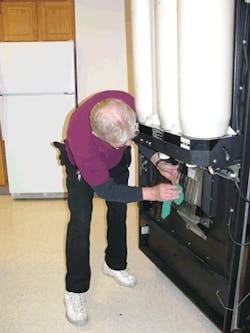Cleaning: A Key Part of Servicing the Account
Correct cleaning and servicing practices relating to servicing of vending machines are the mark of an expert. Not everyone has the knack or the know-how to perform these practices when they begin a career in the vending industry, but these procedures can be learned.
The National Automatic Merchandising Association produces the Route to Success Service Fundamentals for Route Drivers Handbook that is intended as a basic guide for the route service driver who wants to be a professional in his or her work.
Drivers: Foodservice Personnel
In today's food and beverage vending industry, a surprising number of staff are considered "foodservice personnel" by legal definition. These include not only commissary staff, but also vending route service drivers, hostesses, supervisors, shop technicians, field installation and repair technicians. Each one of these individuals handles cups, commodities, unwrapped foods or the food contact parts of vending machines at some time.
All suggested procedures in this article are based on the requirements of the Food and Drug Administration's U.S. Public Health Service "1999 Model Food Code" and the many state and local vending regulations which are patterned after this model code.
Cleaning has a direct bearing on a vending company's survival, success and is an essential component of the vending business.
Why is cleaning so important? For the following reasons:
Cleaning Keeps Customers Healthy
Poor cleaning procedures in the commissary, on the truck or at the machine can cause foodborne illness, chemical poisoning or customer complaints, particularly where perishable foods are involved.
Bad publicity, lawsuits and customer rejection resulting from any of these situations will severely limit growth and employment opportunities.
Cleaning Keeps Your Customers Happy
Today's customers insist on cleanliness in food establishments or they won't patronize them. Protection against disease is not enough. Your customers want a clean vending location, clean looking equipment, quality products and neat looking personnel.
Unless a vending company can give their customers what they want in the matter of cleanliness, the company stands to lose its current customers and to attract fewer new ones. Repeat business and new business are both vital to a company's survival and growth.
Cleaning Keeps Fellow Employees Happy
Professional vending route service drivers need to recognize that good cleaning and servicing practices are the key to safe, high-quality food products and to customer satisfaction. This benefits not only the customers, but fellow employees as well.
If the machine is clean, filled and working, it's a reflection of the company's high standards and will produce maximum sales. Maximum sales means better business for the company and for everyone concerned.
Cleaning Keeps Regulatory Agencies Satisfied
Vending operations are required to meet certain standards for cleaning under the health laws of all 50 states, federal regulations and in military jurisdictions. Machines, locations or commissaries closed for failure to meet these standards can result in loss of sales, reputation and less income all-around.
In most companies, route drivers are responsible for the cleanliness of cups, commodities, perishable foods and replacement parts from the moment they are received at the warehouse and loaded on their truck.
Transporting Potentially Hazardous Foods
If the truck is used to deliver sandwiches and other potentially hazardous foods, they must be kept at safe temperatures during the entire trip. Safe temperatures are 41 degrees Fahrenheit or lower for cold food and 140 degrees Fahrenheit or higher for hot food.
Keep potentially hazardous foods at safe temperatures by using insulated, portable carriers or permanent insulated boxes during transit. If the truck is not a dedicated, temperature controlled vehicle, the company should be using mechanical refrigeration, canned refrigerant, cold plates or dry ice to hold safe temperatures until the last stop. A thermometer should be present in each container to monitor the temperature during delivery.
Drivers or warehouse personnel should precool insulated containers in the commissary walk-in refrigerator prior to loading the truck with refrigerated food.
Handling Potentially Hazardous Foods at the Location
Service personnel should load perishable products into machines as quickly as possible or store them in a stand-by refrigerator.
Sandwiches and other perishables that are allowed to warm up during route pack out or delivery to the location or held in a noninsulated carrier while other machines are serviced cannot be guaranteed safe and as top quality.
Check the machine thermometer and report cold units running above 41 degrees Fahrenheit or hot units below 140 degrees Fahrenheit. The temperature cut-off control is not working if this happens.
If other suppliers load the company's milk and ice cream machines, drivers should periodically check product temperatures, sample for stale or sour products and be sure to watch the dates on dated products.
Remember, you are responsible for maintaining the quality of all perishable food during transit on your route. A properly operating cold food machine can't improve perishable food that arrives at the location in poor quality because it was stored during delivery at incorrect temperatures.
